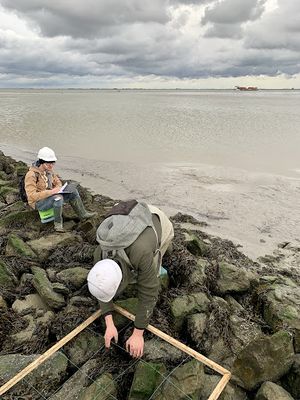PR 00295: verschil tussen versies
Geen bewerkingssamenvatting |
Geen bewerkingssamenvatting |
||
| (4 tussenliggende versies door 2 gebruikers niet weergegeven) | |||
| Regel 1: | Regel 1: | ||
[[Bestand:Students working.jpg|miniatuur|HZ students working in the field at Knuitershoek, performing an ecological survey.]] | [[Bestand:Students working.jpg|miniatuur|HZ students working in the field at Knuitershoek, performing an ecological survey.]] | ||
Within the Westernscheldt there is a need for nature compensation due to the dredging of the Scheldt. The | Within the Westernscheldt there is a need for nature compensation due to the dredging of the Scheldt. The Province of Zealand has decided to add natural value to the Baalhoek and Knuitershoek by creating low flow velocity areas. With the change in velocity, there will also be a change in sedimentation and erosion rates, creating new dynamics in the research area. | ||
The project 'Buitendijkse Maatregelen' will be used as a monitoring program focusing on ecological changes and changes in the hydraulics. The main goal is to be able to supply the right stakeholders with spatial patterns based on morphological information (sediment height). From this information the projectteams can determine weather or not the desired sedimentation velocity is reached or it can make changes to reach this velocity. Within this research project the main questions we are trying to answer are: | The project 'Buitendijkse Maatregelen' will be used as a monitoring program focusing on ecological changes and changes in the hydraulics. The main goal is to be able to supply the right stakeholders with spatial patterns based on morphological information (sediment height). From this information the projectteams can determine weather or not the desired sedimentation velocity is reached or it can make changes to reach this velocity. Within this research project the main questions we are trying to answer are: | ||
| Regel 10: | Regel 10: | ||
'''Location:''' Knuitershoek & Baalhoek, Zeeland | '''Location:''' Knuitershoek & Baalhoek, Zeeland | ||
'''Contact:''' Tim van Ooijen | '''Contact:''' {{External link|resource=Resource Hyperlink 00707|name=Tim van Ooijen|dialog=process-linkwebsite-dialog}} | ||
{{Project config}} | {{Project config}} | ||
{{Project | {{Project | ||
| Regel 22: | Regel 23: | ||
|Show summary=Nee | |Show summary=Nee | ||
|Contact person=CNTR 00009 | |Contact person=CNTR 00009 | ||
|Stakeholder=STKH 00061, | |Stakeholder=STKH 00061,STKH 00064,STKH 00069,STKH 00070, | ||
|Show extra=Nee | |Show extra=Nee | ||
|Show navigation tree=Ja | |Show navigation tree=Ja | ||
Huidige versie van 24 mrt 2020 om 12:36
Within the Westernscheldt there is a need for nature compensation due to the dredging of the Scheldt. The Province of Zealand has decided to add natural value to the Baalhoek and Knuitershoek by creating low flow velocity areas. With the change in velocity, there will also be a change in sedimentation and erosion rates, creating new dynamics in the research area.
The project 'Buitendijkse Maatregelen' will be used as a monitoring program focusing on ecological changes and changes in the hydraulics. The main goal is to be able to supply the right stakeholders with spatial patterns based on morphological information (sediment height). From this information the projectteams can determine weather or not the desired sedimentation velocity is reached or it can make changes to reach this velocity. Within this research project the main questions we are trying to answer are:
- 'What is the sedimentation velocity in the project area and areas surrounding it?'
- 'What processes determine sedimentation velocity within these areas?'
- 'How can the sedimentation velocity be influenced, in case the current velocity does not comply with the desired conditions?'
Research type: field research, desk analysis, lab research
Location: Knuitershoek & Baalhoek, Zeeland
Contact: Tim van Ooijen

